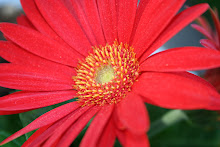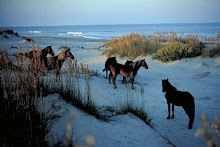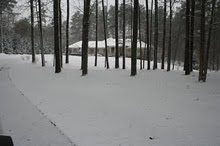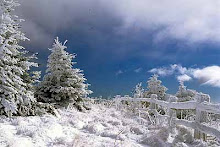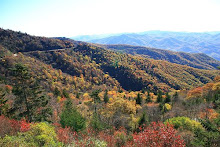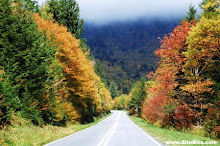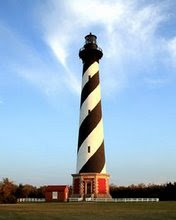 24 Days Until Christmas!!
24 Days Until Christmas!!Can you believe it? Where the 2008 go? It seems like we were just discussing spring time planting.
North Carolina is brimming with holiday spirit. Beautiful crisp blue sky days makes our holiday weather perfect for enjoying the outdoors -- whether it's piling the kids in the car with hot chocolate to check out the lights, enjoying winter sporting activities in Asheville, or taking the family skiing at one of the many nearby ski resorts. Nearly every family has its own traditions.
The Recca family puts up our Christmas lights the week before Thanksgiving so we can light up the neighborhood Thanksgiving night. It's a tradition we've been following since Sal was little. We're usually the first in the area to have our lights up and on.
Along with decorating the house, we typically venture out on at least one holiday excursion. Last year we drove up to Washington, DC (only 4 hours away) the week before Christmas to check out the State Trees and a few museums. We may even do that again this year. But one of our favorite places to go during the Christmas season is The Biltmore Estate, over in Asheville, NC.
The Biltmore Estate was actually first opened on Christmas Eve in 1895.
(click here to see some pictures of Christmas at the Biltmore)
I'm a history buff by nature, and love reading about places that we are planning to visit, or have visited already. If you're interested in a brief history of The Biltmore Family Estate, read on. I stumbled across this information somewhere on the internet ( I can't remember where.) It's a pretty interesting story.
In 1888, George Vanderbilt, youngest grandson of business tycoon Commodore Cornelius Vanderbilt, visited the Western North Carolina mountains with his mother. Asheville, North Carolina was a high-society health retreat for those looking for a rugged, yet pleasant retreat from the pressures of the Northeast. At 26, George Vanderbilt recognized the area as a perfect spot for an estate. He envisioned an estate that would not only showcase his collection of art, but also become a self-supporting business. He had traveled extensively throughout Europe, and believed he could bring a landed barony to America.
Also, George Vanderbilt was not without his competitive streak, and sought to create an estate to rival those belonging to his siblings in the Northeast. The Vanderbilts had a tradition of building lavish homes, a tradition begun by the Commodore. As a self-made man, Cornelius Vanderbilt and his wife Sophia found themselves not entirely accepted into Northeastern fashionable society so their lavish homes became a symbol of both their success and their gentility.
George Vanderbilt purchased 125,000 acres of land. Today, both Pisgah Forest and the town of Biltmore Village occupy land once owned by Vanderbilt. He called his holdings "Biltmore" - combining Bilt, the name of the Dutch town where his ancestor's originated, and more, the Old English word for open rolling land. Then Vanderbilt assembled his design team for the future estate.
Richard Morris Hunt, a popular society architect, became the designer of the Biltmore House. He had already built several homes for George's brothers in the Northeast. Hunt modeled the Biltmore House after early 16th-centure French châteaux. The design was very ornate and required an immense amount of materials. A special rail spur had to be laid between the depot in a neighboring village and the estate to carry the tons of materials used. Construction of the house required an immense amount of manpower, from the local laborers to world-renowned craftsmen. Vanderbilt spared no expense and, in fact, found himself in some financial difficulties by the time the estate was finished. Even the incredible wealth of the Vanderbilts had limits.
Vanderbilt wanted his house to be not only a showcase for his extensive art collection, but also a technological marvel. Vanderbilt included such cutting-edge technology as central heating, electricity, running hot and cold water to upstairs baths, a fire alarm, cold-storage mechanical refrigeration (using circulating chilled brine solution), an elevator, an electric communication system for calling servants, and a swimming pool with underwater lighting. Guests often marveled at these wondrous conveniences.
A prestigious landscape architect, Fredrick Law Olmstead, supervised the surrounding grounds. Olmstead had designed parks, including New York's Central Park and the U.S. Capitol grounds, and was a pioneer in conservation. Although Vanderbilt had originally wanted extensive parkland, Olmstead recommended a combination of a 250-acre pleasure park surrounded by commercial timber forest. This plan worked nicely with Vanderbilt's desired for the estate to be profitable. Renovation of the forest was handed over to Gifford Pinchot, who later established the U.S. Forest Service.
Olmstead's mix of wild areas and formal gardens could deceive at first glance. For example, the three-mile-long approach road to the house appears to snake through natural forest. In reality, the land was too overworked, overcut and rough in its natural state. Olmstead virtually sculpted the land before planting anything. Then he transplanted seedlings from all over North Carolina. These native plants were supplemented with plants grown in the Biltmore nursery, including decidedly non-native plants such as the bamboo groves. The design of the approach road intended to mix deciduous trees, pines and shrubs to offer an interesting drive during any time of year.
The estate was formally opened on Christmas Eve 1895, though even then, some of the rooms in the house were not complete and remain so even today. In 1898, Vanderbilt married socialite Edith Stuyvesant Dresser. Together, the Vanderbilts became known as excellent employers throughout the area. In addition to employing an 80-person staff, the estate also contained working farms and a commercial timber operation with its own mill.
George Vanderbilt introduced new farming techniques to the region and was instrumental in the founding of the Biltmore Forest School, the first institute for scientific forestry in America. The conservation techniques of these early foresters remain influential in American forestry today. The Vanderbilts also started Biltmore Industries to teach traditional handcrafts such as woodworking and weaving. Mrs. Vanderbilt also set up the School for Domestic Science to train young women in housekeeping skills. These training opportunities allowed local people to make better wages.
After the death of George Vanderbilt in 1914, Edith Vanderbilt continued to be active in community affairs. She deeded close to 87,000 acres to the federal government to preserve Pisgah Forest for public enjoyment. The Vanderbilts' daughter Cornelia married John Cecil in 1924. Edith Vanderbilt moved out of the house in 1925, when she married Senator Peter G. Gerry, and left the Cecils to manage Biltmore affairs. In 1930, the Cecils opened the estate to the public in order to revitalize Asheville's economy with a tourism boon.
Even today, George Vanderbilt's grandchildren continue to benefit the region through employing a 650-person staff to maintain Biltmore House for public enjoyment. Change also continues, in 1979, William Cecil remodeled the Biltmore dairy barn to be used as a winery and beef cattle have been added to the farm operation.
If you're planning on paying us a visit here in North Carolina to look at homes, try and save a day or two to check out The Biltmore Estate. The Asheville area is beautiful any time of year, but particularly so during the holidays.
